From minor cuts and scrapes to more serious issues like collapsing and broken bones, Petplan veterinary expert Brian Faulkner advises how you can help and comfort your cat before taking them to the vet.
We do everything we can to keep our cats safe — but sometimes accidents happen. While it’s always best that your cat receives professional treatment from a vet as soon as possible, there are some key first aid techniques you can use to help them immediately after an accident.
What can I do if my cat is bleeding?
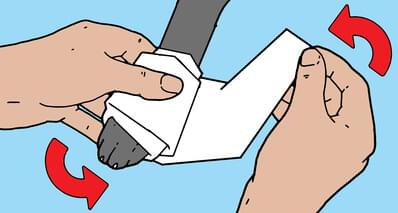
The first thing to do is see if you can figure out where the blood is coming from, then assess the size and depth of the wound. If your cat lets you, apply firm pressure over the injury using a clean tea towel or handkerchief. If you have a first aid kit, you can wrap the injury with a bandage or some tape until you can take your cat to the vet. Bandaging the wound will help slow the flow of blood and also keep it as clean as possible.
If your cat has been bitten by another cat, the bleeding tends to stop fairly quickly, but the wound will be very sore and could become abscessed. Often, bite injuries can tear deeper tissues as your cat tries to pull away. Don’t be tempted to give your cat any pain medication like aspirin at home, because these aren’t suitable for cats. Make an appointment with your vet so they can assess the wound and prescribe any necessary medication.
What can I do if my cat has broken a bone?
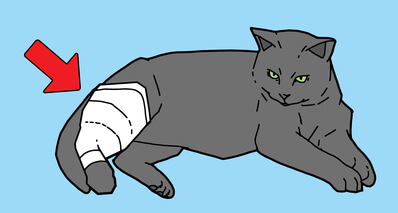
Road traffic accidents are a common cause of injuries to cats, and can result in broken bones. Sometimes, you might suspect your cat has a broken bone but you might not see any evidence other than them limping or showing signs of pain. In the case of a compound fracture though, you’ll clearly see a broken bone protruding. In either case, call your vet and make an appointment immediately. In the meantime, there’s not a lot you can do.
For a compound fracture, you can try to lightly cover the injured area to keep it as clean as possible. Don’t try to apply a splint as it might end up making your cat’s injury worse.
What can I do if my cat is choking?
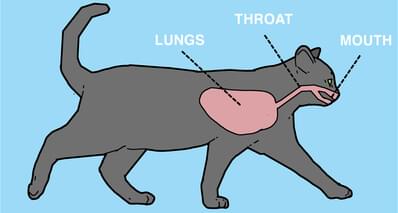
Cats rarely choke on round objects like small balls, as their airways are very well protected. But swallowing string or other household items they’ve decided to play with or chew on is a common reason for insurance claims. These objects can cause blockages and, in the case of string, can become tangled in your cat’s digestive system.
If you suspect your cat has swallowed something and it’s either obstructing their airways or digestive system, the best thing to do is to make an appointment with your vet as soon as possible. In the meantime, keep an eye on your cat’s breathing. If you can see a blockage, don’t attempt to remove it yourself. Cat’s teeth are covered in bacteria and if you get bitten, it may result in a nasty infection.
What can I do if my cat has stopped breathing?
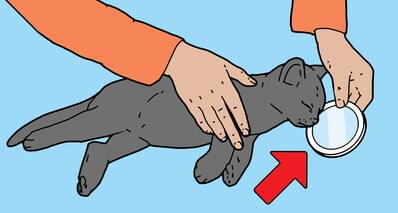
A cat’s breathing patterns can be very subtle and sometimes it may look like they’ve stopped breathing when they’re really in a deep sleep. If your cat is stressed or panicked, their breathing rate increases and it’s much easier to see them taking each breath.
When checking your cat’s breathing, first look at their ribcage and see if you can notice it rising and falling. If it’s not obvious, you can hold a cold mirror against their nostrils. As they breathe, condensation should form. If your cat has stopped breathing, follow the instructions below and take them to the vet for an urgent appointment.
What can I do if my cat has collapsed?
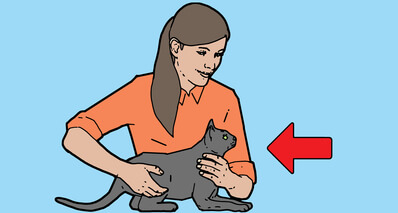
If your cat has stopped breathing, or lost consciousness, and you can’t feel their heartbeat, you should call your vet for an urgent appointment. Performing mouth-to-nose cardiopulmonary resuscitation (CPR) on cats isn’t recommended. In addition to the risks of contamination, their fragile rib bones can easily be broken or their heart and lungs can be accidentally punctured during compressions.
Place your cat in the sternal position pictured above. This involves placing your cat on their tummy, with their front paws out ahead of them. The sternal position helps to straighten the airways and allows for better airflow while your cat’s rib cage can move unobstructed against the floor.
If your cat won’t allow you to hold them in this position, it’s usually a good sign! Don’t force your cat as this may make them feel more stressed. Make an urgent appointment with your vet. In the meantime, see if you notice anything that may have caused your cat to collapse. Have they eaten something they shouldn’t, been hit by a car, or got into a fight?
What can I do if I can’t feel my cat’s heartbeat?
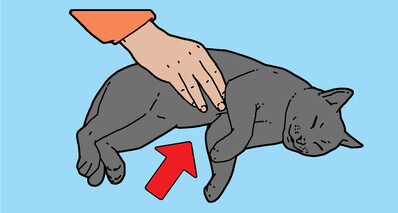
To check your cat’s heartbeat, place your finger either side of their ribcage, between their front legs. Apply gentle pressure and you should be able to feel their heartbeat. If you can’t, place your cat in the position described above and take them to the vet immediately.
It can be worrying and scary when our cats hurt themselves. You know your cat best, so it’s always safest to take them to see your vet as soon as possible whenever you’re concerned. But by knowing how to perform some basic cat first aid, you can help keep your cat as calm and comfortable as possible while you get them there.
